
SiPearl, a processor designer supported by the European Processor Initiative, is about to start shipments of its very first Rhea processor for high-performance computing workloads. But the company is already working on its successor currently known as Rhea-2, which is set to arrive sometimes in 2026 in Exascale supercomputers.
SiPearl’s Rhea-1 datacenter-grade system-on-chip packs 72 off-the-shelf Arm Neoverse V1 cores designed for HPC and connected using a mesh network. The CPU has an hybrid memory subsystem that supports both HBM2E and DDR5 memory to get both high memory bandwidth and decent memory capacity as well as supports PCIe interconnects with the CXL protocol on top. The CPU was designed by a contract chip designer and is made by TSMC on its N6 (6 nm-class) process technology.
The original Rhea is to a large degree a product aimed to prove that SiPearl, a European company, can deliver a datacenter-grade processor. This CPU now powers Jupiter, Europe’s first exascale sysatem that uses nodes powered by four Rhea CPUs and NVIDIA’s H200 AI and HPC GPUs. Given that Rhea is SiPearl’s first processor, the project can be considered as fruitful.
With its 2nd generation Rhea processors, SiPearl will have to develop something that is considerably more competitive. This is perhaps why Rhea-2 will use a dual-chiplet implementation. Such a design will enable SiPearl to pack more processing cores and therefore offer higher performance. Of course, it remains to be seen how many cores SiPearl plans to integrate into Rhea 2, but at least the CPU company is set to adopt the same design methodologies as AMD and Intel.
Given the timing for SiPearl’s Rhea 2 and the company’s natural with to preserve software compatibility with Rhea 1, it is reasonable to expect the processor to adopt Arm’s Neoverse V3 cores for its second processor. Arm’s Neoverse V3 offer quite a significant uplift compared to Neoverse V2 (and V1) and can scale to up to 128 cores per socket, which should be quite decent for HPC applications in 2025 – 2026.
While SiPearl will continue developing CPUs, it remains to be seen whether EPI will manage to deliver AI and HPC accelerators that are competitive against those from NVIDIA, AMD, and Intel.








